Amon Carter had two go-to guys at the Star-Telegram: C. L. Richhart for newspaper reporting, from communes to canals, and Harold Hough for technology, from radio to television.
What an innovator Harold Hough was. He was born in 1887 when no one had driven a car or flown an airplane, and few people had heard Edison’s wax-cylinder phonograph. In 1912 Hough joined the Star-Telegram as circulation manager. Nine years later Carter drafted Hough to build, from scratch, the latest thing: a radio station (“whatever the heck that is”).
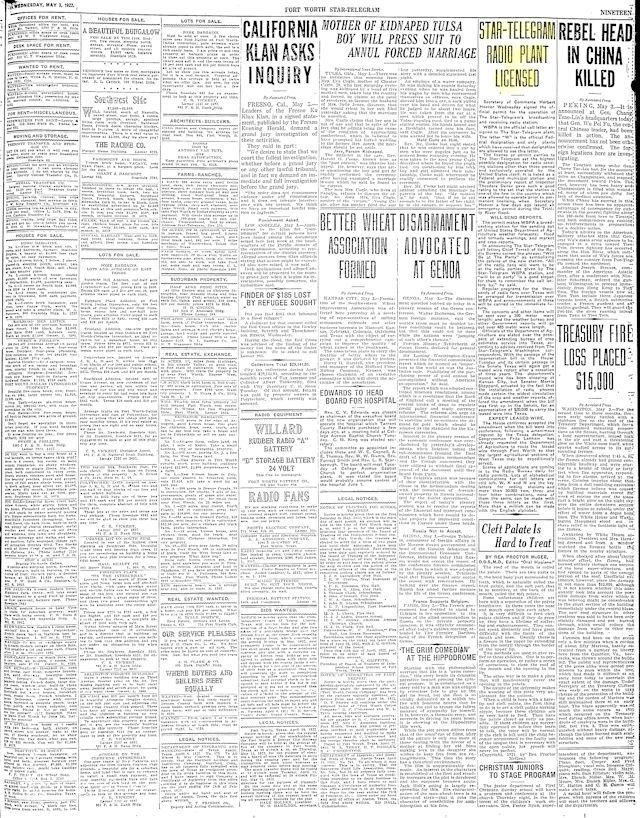 A year later, on May 3 on page 19 of a twenty-page edition, tucked in with classified ads and a story about the Ku Klux Klan, was a one-column headline reading “Star-Telegram Radio Plant Licensed.” The report said that on May 2, 1922 Secretary of Commerce Herbert Hoover signed “the official permit for the operation of the Star-Telegram’s broadcasting and receiving station.” According to WBAP’s website, Hoover said the mnemonic for the station’s call letters—WBAP—was “We Bring A Program.”
A year later, on May 3 on page 19 of a twenty-page edition, tucked in with classified ads and a story about the Ku Klux Klan, was a one-column headline reading “Star-Telegram Radio Plant Licensed.” The report said that on May 2, 1922 Secretary of Commerce Herbert Hoover signed “the official permit for the operation of the Star-Telegram’s broadcasting and receiving station.” According to WBAP’s website, Hoover said the mnemonic for the station’s call letters—WBAP—was “We Bring A Program.”
 Like all pioneers, Hough had to make it up as he went along as he built WBAP radio. He was WBAP’s first broadcaster, first ringer of the cowbell, and first station manager.
Like all pioneers, Hough had to make it up as he went along as he built WBAP radio. He was WBAP’s first broadcaster, first ringer of the cowbell, and first station manager.
Fast-forward twenty-four years. In 1946 Carter again drafted Hough, this time to build, from scratch, the latest latest thing: a television station (“whatever the heck that is”).
As with radio, Hough had to make it up as he went along as he pioneered WBAP-TV. But this time he had the experience of pioneering the previous latest thing to guide him in pioneering the latest latest thing.
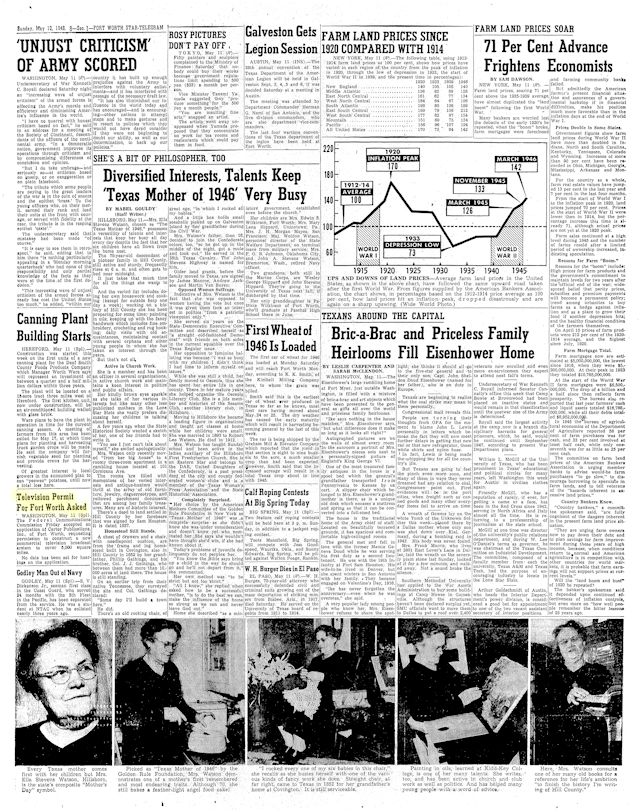 On May 12, 1946 on page 8 of the Star-Telegram, tucked in with stories about farm land prices and Eisenhower bric-a-brac, was a brief modestly announcing that the Federal Communications Commission had accepted an application from Carter Publications requesting permission to build a “commercial television broadcast system.”
On May 12, 1946 on page 8 of the Star-Telegram, tucked in with stories about farm land prices and Eisenhower bric-a-brac, was a brief modestly announcing that the Federal Communications Commission had accepted an application from Carter Publications requesting permission to build a “commercial television broadcast system.”
 In 1921 Amon Carter had given Harold Hough $300 ($4,500 today) to build WBAP radio. Carter was more generous with Hough when it came to WBAP-TV. Construction of the new station alone cost $1.5 million ($16 million today).
In 1921 Amon Carter had given Harold Hough $300 ($4,500 today) to build WBAP radio. Carter was more generous with Hough when it came to WBAP-TV. Construction of the new station alone cost $1.5 million ($16 million today).
The state-of-the-art broadcast center on a hilltop in Meadowbrook would house AM and FM radio and TV operations, transmitting from a 502-foot-tall tower. The center would include a four hundred-seat auditorium, three TV studios, 74,000 square feet of floor space. Joseph Pelich designed the building.
Until the new center was completed, WBAP-TV would broadcast from Medical Arts Building.
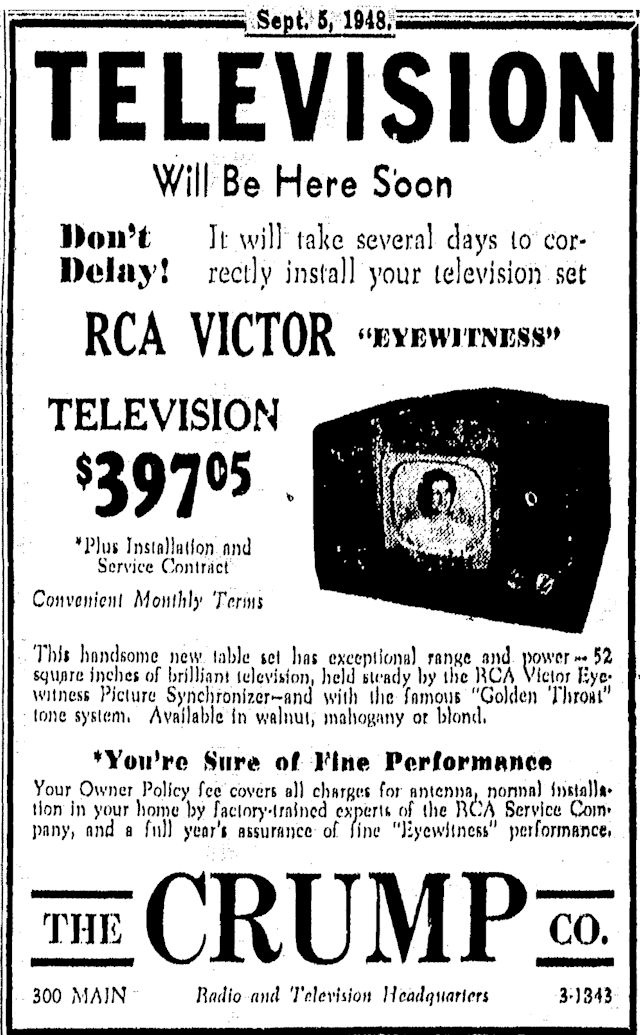 “Television will be here soon.” And it won’t be cheap: $397 would be $4,200 today. Fifty-two square inches is about 7.2 inches on a side.
“Television will be here soon.” And it won’t be cheap: $397 would be $4,200 today. Fifty-two square inches is about 7.2 inches on a side.
 In mid-September 1948 WBAP-TV began transmitting a half-kilowatt test signal. Dallas reported good reception.
In mid-September 1948 WBAP-TV began transmitting a half-kilowatt test signal. Dallas reported good reception.
 On September 24 the Star-Telegram reported details of the upcoming premiere telecast on September 29.
On September 24 the Star-Telegram reported details of the upcoming premiere telecast on September 29.
But before September 29 arrived, the man from Missouri arrived, presenting Amon Carter and Harold Hough with an opportunity too good to resist.
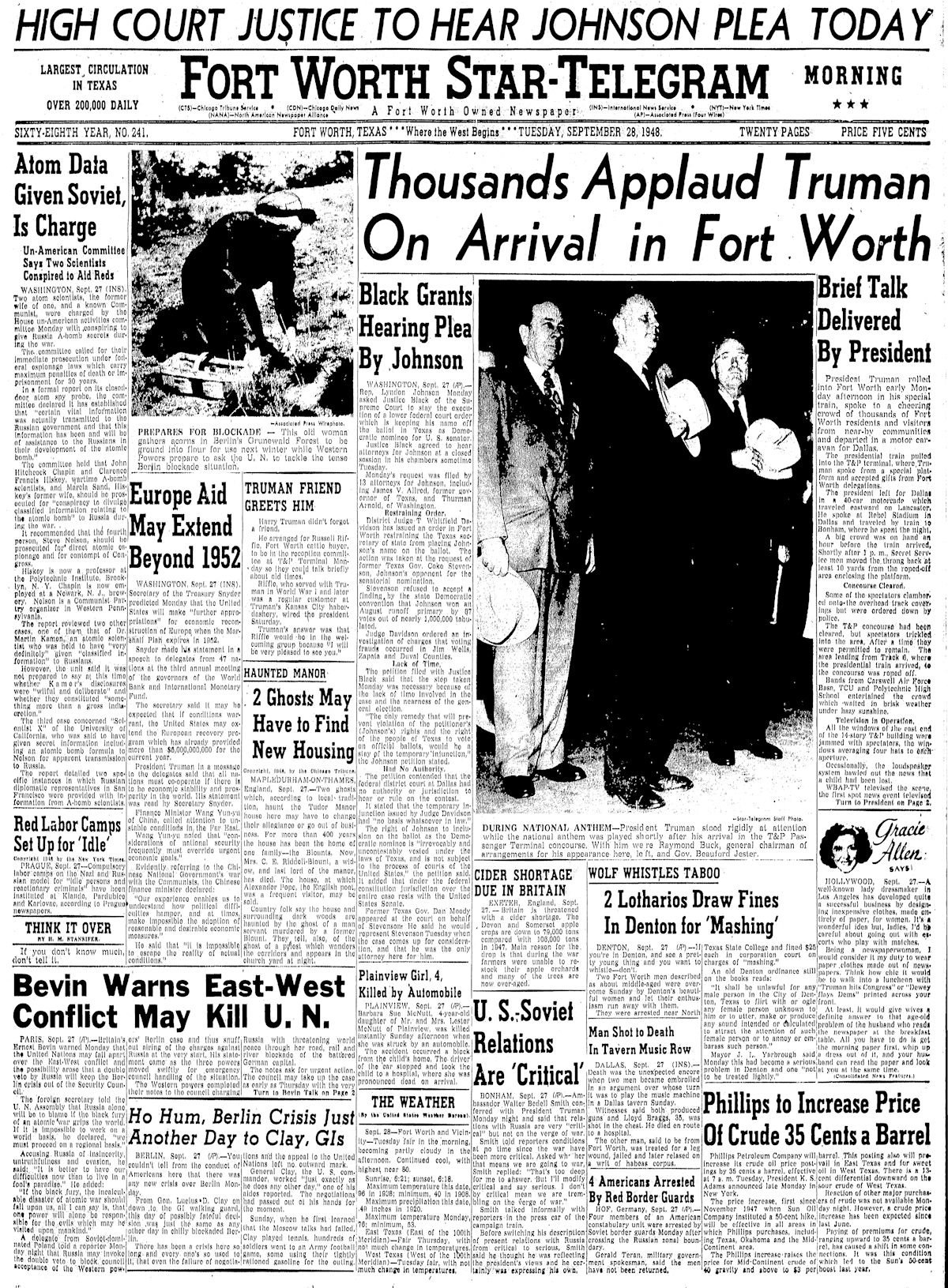 On September 27 President Harry S. Truman arrived at the Texas & Pacific passenger station. He was greeted by Amon Carter and others, presented with the obligatory five-gallon western hat, and spoke briefly.
On September 27 President Harry S. Truman arrived at the Texas & Pacific passenger station. He was greeted by Amon Carter and others, presented with the obligatory five-gallon western hat, and spoke briefly.
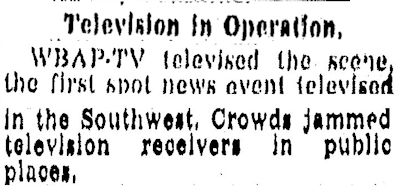 What made a special occasion more special was the fact that for many people in Fort Worth that day the first person they ever saw on television was the president of the United States: WBAP-TV with three cameras and a mobile van broadcast the event live. About four hundred viewers watched the forty-seven-minute broadcast at home on their new black-and-white sets. Many more crowded around sets in public places.
What made a special occasion more special was the fact that for many people in Fort Worth that day the first person they ever saw on television was the president of the United States: WBAP-TV with three cameras and a mobile van broadcast the event live. About four hundred viewers watched the forty-seven-minute broadcast at home on their new black-and-white sets. Many more crowded around sets in public places.
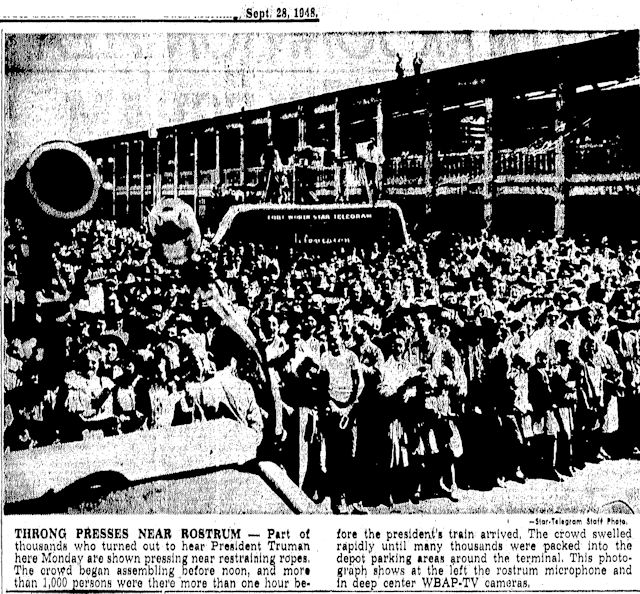 Two WBAP-TV cameras were stationed on top of a van. Another camera was on top of the depot.
Two WBAP-TV cameras were stationed on top of a van. Another camera was on top of the depot.
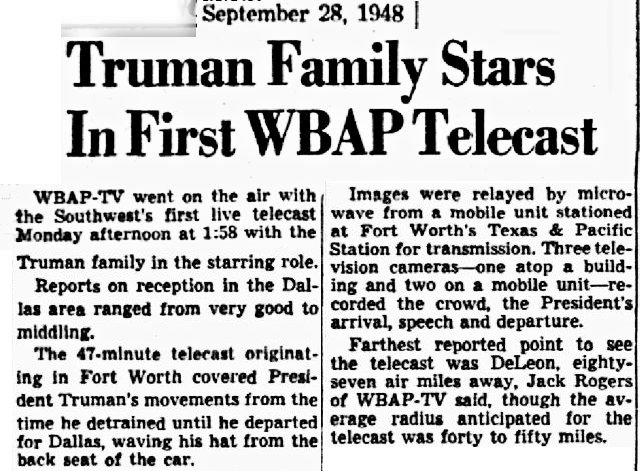 Intercity rivalry be hanged! This was a big deal, even to the Dallas newspaper.
Intercity rivalry be hanged! This was a big deal, even to the Dallas newspaper.
 As in the early days of WBAP radio, WBAP-TV was obsessed with distance, reporting how far away its signal was received.
As in the early days of WBAP radio, WBAP-TV was obsessed with distance, reporting how far away its signal was received.
 On the day of the official premiere broadcast, this page shows how established radio was and how limited WBAP-TV’s early programming was. Note the ad for the Milton Berle radio program.
On the day of the official premiere broadcast, this page shows how established radio was and how limited WBAP-TV’s early programming was. Note the ad for the Milton Berle radio program.
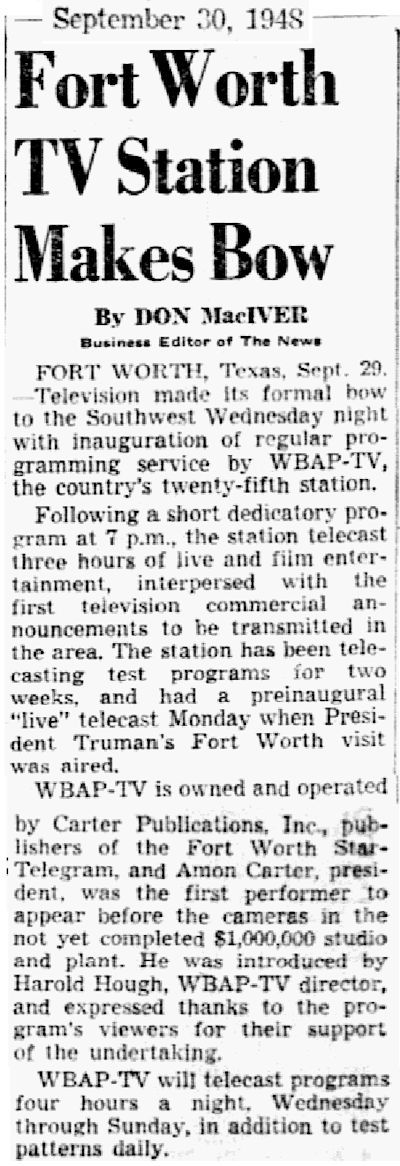 That night the premiere broadcast, fittingly, included speeches by Amon Carter and Harold Hough. The short broadcast schedule included a dedication film from NBC, a western variety show featuring the Flying X Ranch Boys, and the 1934 movie The Scarlet Pimpernel.
That night the premiere broadcast, fittingly, included speeches by Amon Carter and Harold Hough. The short broadcast schedule included a dedication film from NBC, a western variety show featuring the Flying X Ranch Boys, and the 1934 movie The Scarlet Pimpernel.
The next day Jack Gordon of the Fort Worth Press wrote, “A part of Fort Worth’s inaugural television show last night looked like our first roll of home movie film. But a good deal more of it was excellent—enough so to convince the stubbornest critic that television is here to stay.”
WBAP-TV was the only television station between St. Louis and Los Angeles.
The first TV station in Dallas, KBTV, would not go on the air until September 17, 1949.
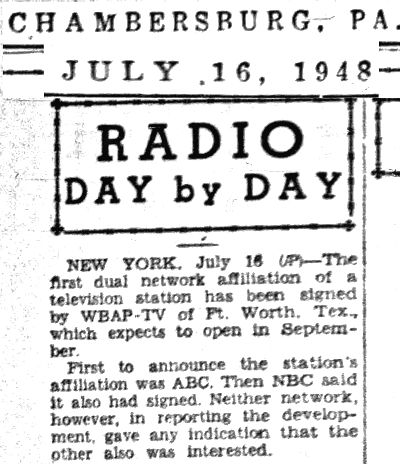 Teletrivia: In the beginning WBAP-TV was affiliated with both ABC and NBC.
Teletrivia: In the beginning WBAP-TV was affiliated with both ABC and NBC.
In the beginning programs from the two networks were created by kinescope: Programs were filmed from a picture tube during their original showing and shipped to network affiliates for broadcast about a week later.
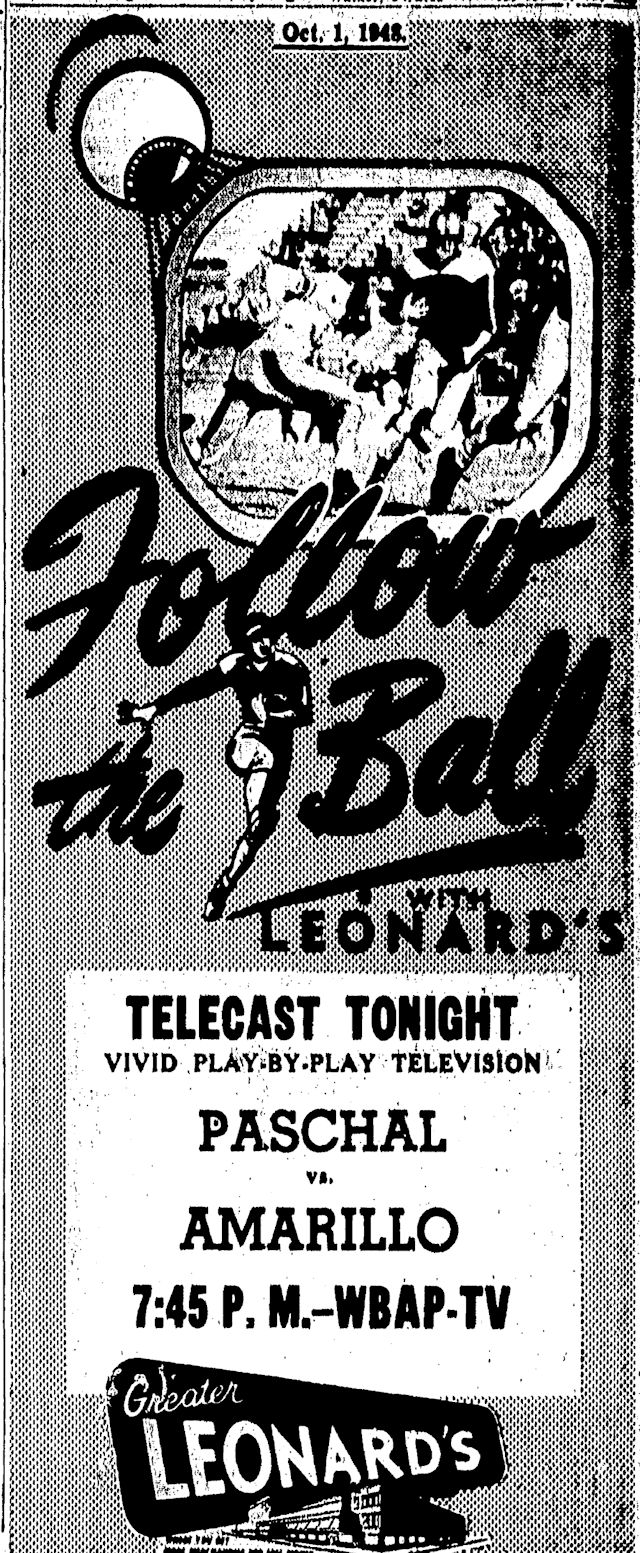 That first week WBAP-TV also broadcast its first sporting event: Paschal versus Amarillo. The broadcast was sponsored by Leonard’s Department Store.
That first week WBAP-TV also broadcast its first sporting event: Paschal versus Amarillo. The broadcast was sponsored by Leonard’s Department Store.
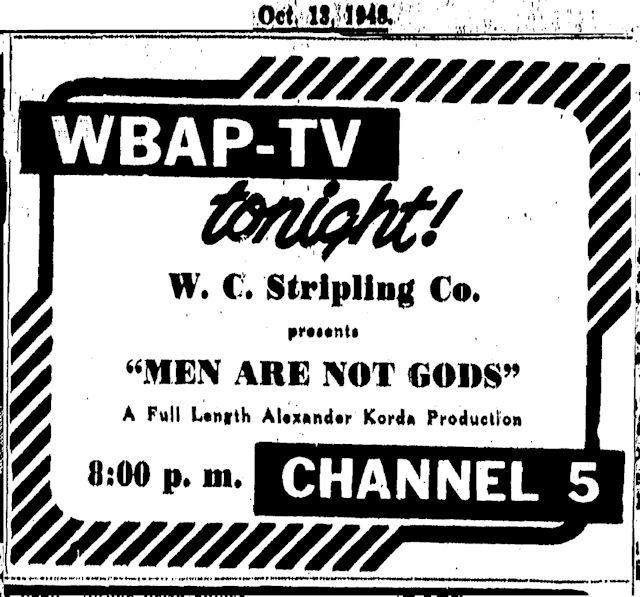 Another early WBAP-TV sponsor was Stripling’s Department Store.
Another early WBAP-TV sponsor was Stripling’s Department Store.
 Three news crews filming with sixteen-millimeter cameras covered Fort Worth-Dallas for WBAP-TV’s Texas News, sponsored by Texas Electric Service Company, whose corporate spokesbolt was Reddy Kilowatt.
Three news crews filming with sixteen-millimeter cameras covered Fort Worth-Dallas for WBAP-TV’s Texas News, sponsored by Texas Electric Service Company, whose corporate spokesbolt was Reddy Kilowatt.
Hear snippets of the Texas News theme music and Reddy Kilowatt’s song:
As might be expected of a television station owned by a newspaper publisher, WBAP-TV focused on news coverage from the first. In late 1949 the Star-Telegram reported that WBAP-TV was one of only two stations in the country that broadcast a daily studio-produced newsreel.
On October 31, 1949 three WBAP meteorologists—including Harold Taft—created the Southwest’s first professional TV weather program, Weather Telefacts (later Telefax).
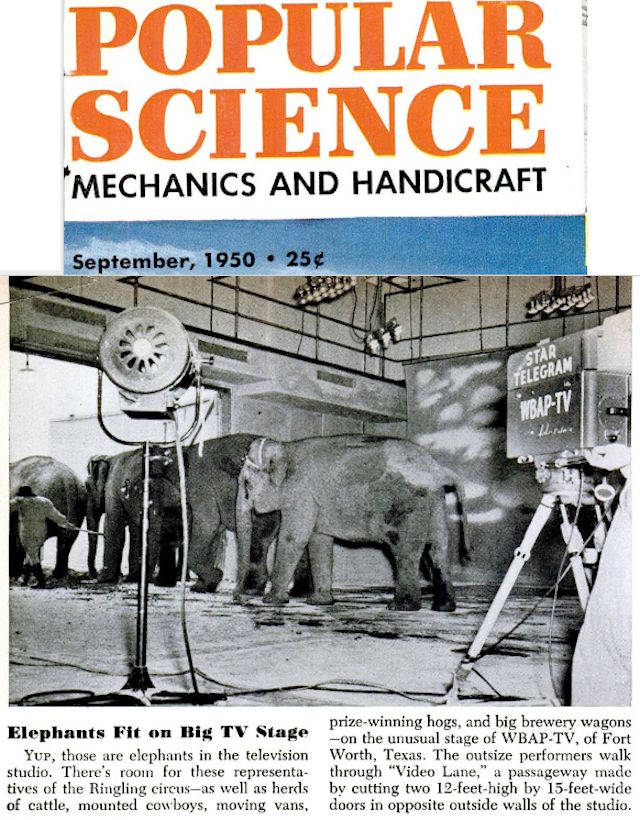 Among Harold Hough’s innovations was the WBAP broadcast center’s Video Lane: 12-by-15-foot doors on both sides of the 45-by-82-foot main studio allowed huge objects both animate and inanimate to be brought through the studio and televised: elephants, herds of cattle, brewery wagons, fire trucks, mounted cowboys, prize-winning hogs.
Among Harold Hough’s innovations was the WBAP broadcast center’s Video Lane: 12-by-15-foot doors on both sides of the 45-by-82-foot main studio allowed huge objects both animate and inanimate to be brought through the studio and televised: elephants, herds of cattle, brewery wagons, fire trucks, mounted cowboys, prize-winning hogs.
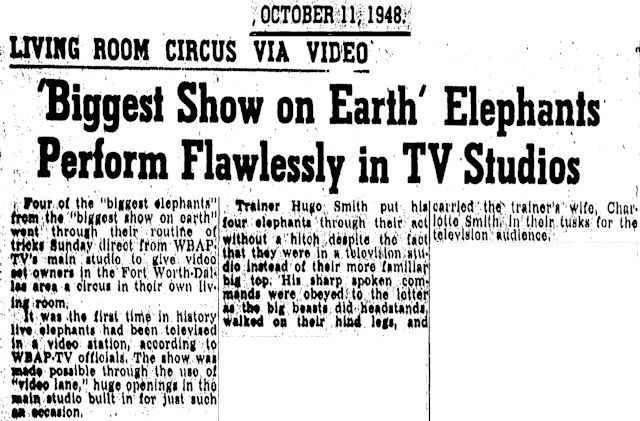 Two weeks after bringing the president of the United States and high school football into living rooms, Harold Hough brought the Ringling Brothers Barnum and Bailey circus—or at least four of its elephants—into living rooms. The elephants were able to enter the main studio because of the Video Lane.
Two weeks after bringing the president of the United States and high school football into living rooms, Harold Hough brought the Ringling Brothers Barnum and Bailey circus—or at least four of its elephants—into living rooms. The elephants were able to enter the main studio because of the Video Lane.
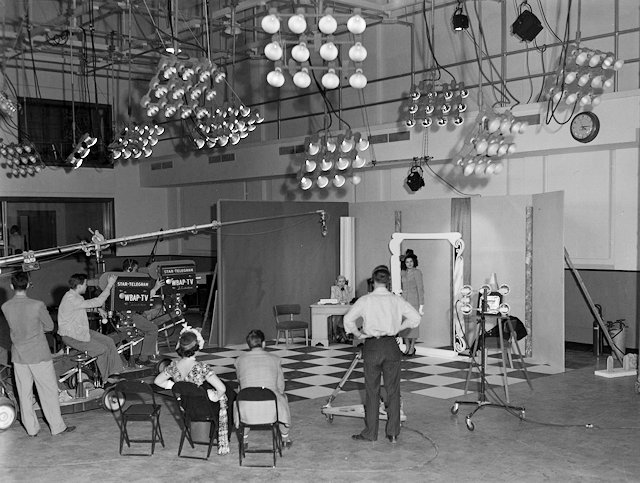 A WBAP-TV set, 1949. (Photo from University of North Texas Special Collections.)
A WBAP-TV set, 1949. (Photo from University of North Texas Special Collections.)
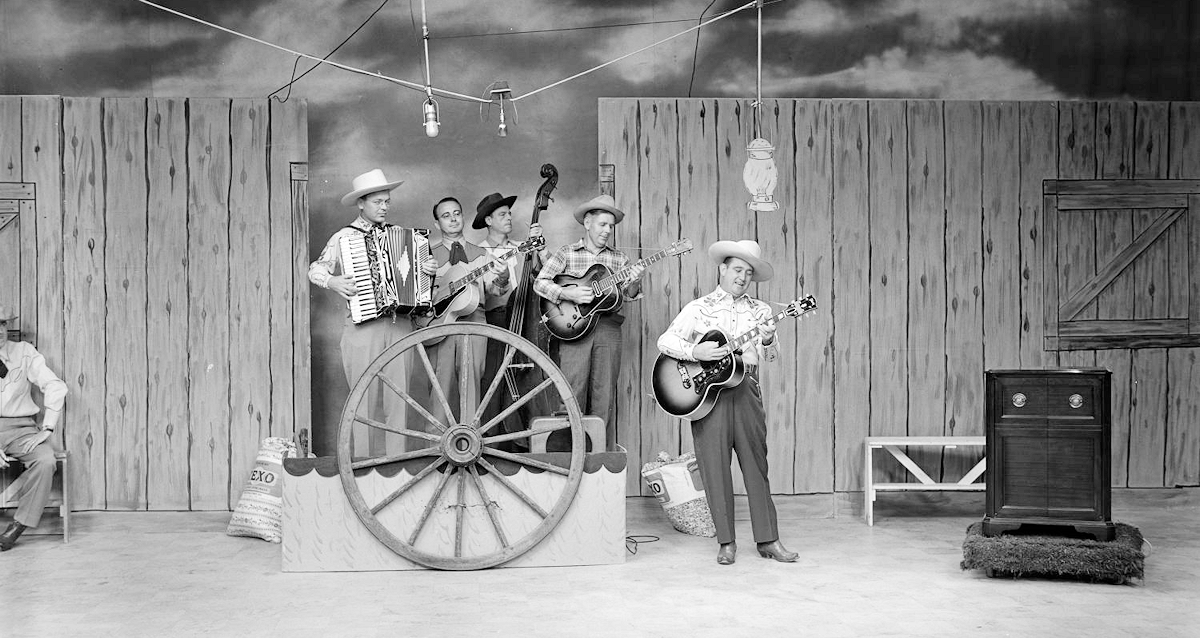 The set of Barn Dance, 1949. (Photo from University of North Texas Special Collections.)
The set of Barn Dance, 1949. (Photo from University of North Texas Special Collections.)
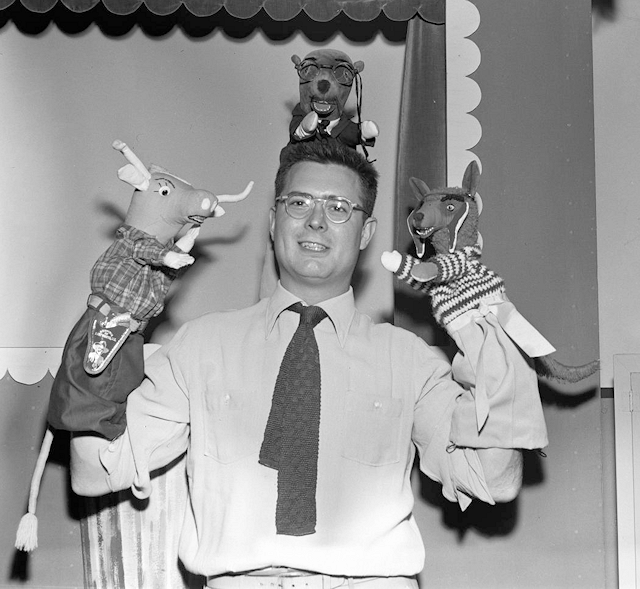 Puppeteer Dean Raymond with characters of See-Saw Zoo, 1949. (Photo from University of North Texas Special Collections.)
Puppeteer Dean Raymond with characters of See-Saw Zoo, 1949. (Photo from University of North Texas Special Collections.)
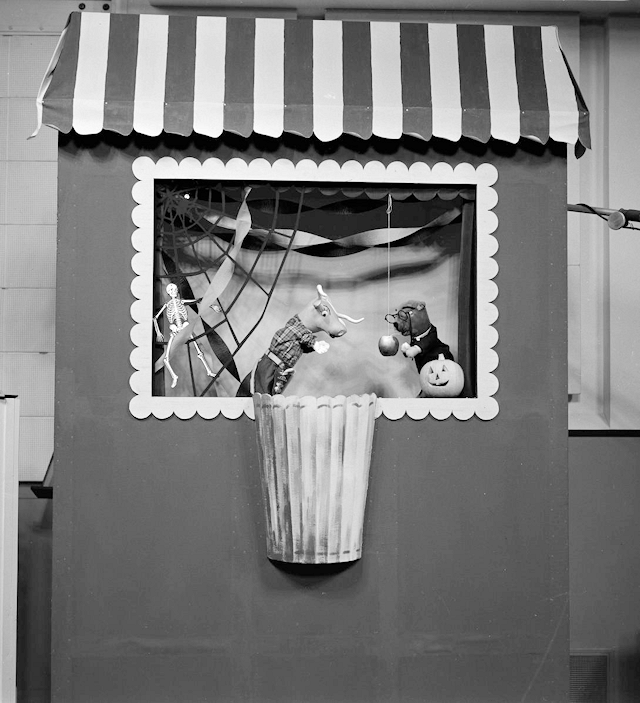 The set of See-Saw Zoo. (Photo from University of North Texas Special Collections.)
The set of See-Saw Zoo. (Photo from University of North Texas Special Collections.)
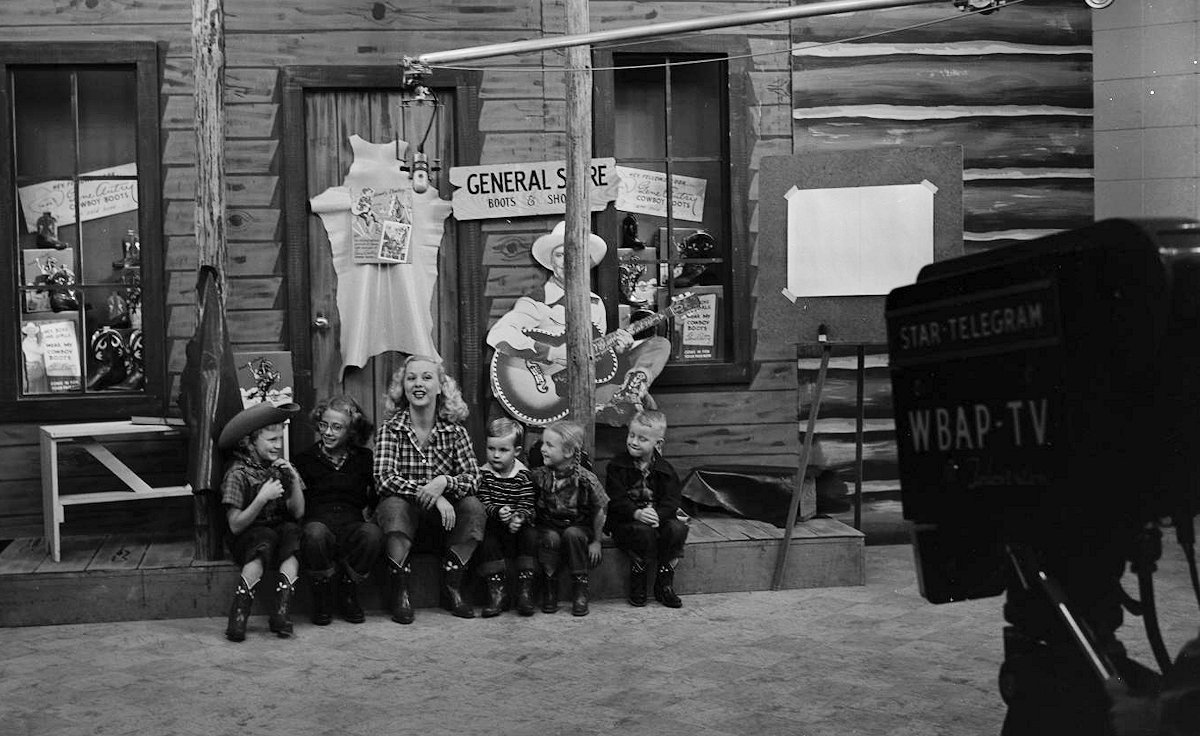 Mary “Punkins” Parker had her own show after returning to Fort Worth from Hollywood. Other early programs on WBAP-TV included Bobby Peters Show and a children’s show featuring Kitty Adkins. Network viewing for children included Lone Ranger and Howdy Doody. (Photo from University of North Texas Special Collections.)
Mary “Punkins” Parker had her own show after returning to Fort Worth from Hollywood. Other early programs on WBAP-TV included Bobby Peters Show and a children’s show featuring Kitty Adkins. Network viewing for children included Lone Ranger and Howdy Doody. (Photo from University of North Texas Special Collections.)
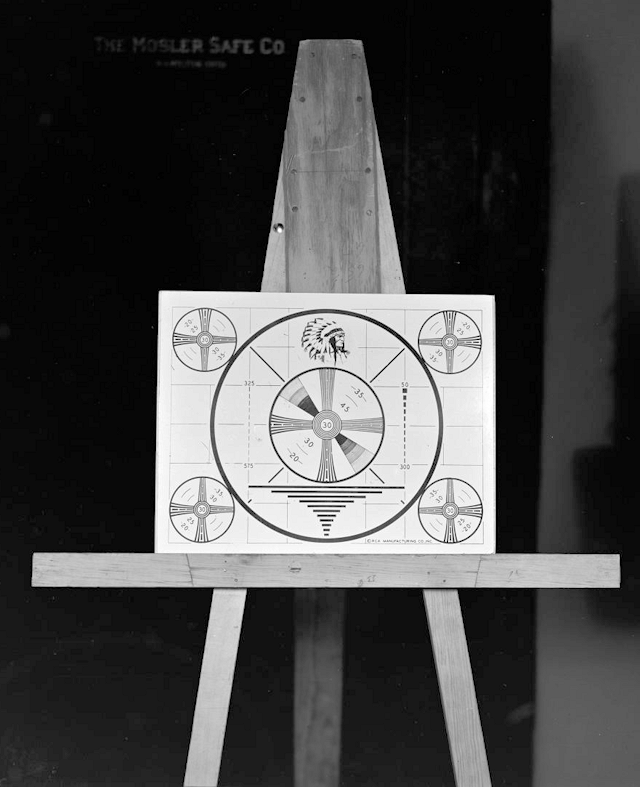 WBAP-TV viewers saw a test pattern a lot in the beginning when the station broadcast only a few hours a day. (Photo from University of North Texas Special Collections.)
WBAP-TV viewers saw a test pattern a lot in the beginning when the station broadcast only a few hours a day. (Photo from University of North Texas Special Collections.)
But that soon changed. Within six months WBAP-TV’s weekly broadcast schedule had increased from fifteen hours to between thirty-five and forty hours.
A year after WBAP-TV went on the air broadcasting to about four hundred TV sets, sixteen thousand homes had TV sets in the WBAP-TV viewing area.
For those early programs, sets were simple, plots were uncomplicated, production values were shaky.
But who noticed? Most of us grew up with television, much as today’s generation grew up with the Internet. It’s hard for us to imagine how amazing the new technology was in 1948. The president of the United States, a local high school football team, circus elephants all appearing, with motion and sound, on that little glass screen on the front of a box in their living room.
Television was magic in a mahogany cabinet.
And it became more magical. Harold Hough and other television pioneers learned as they went and innovated. Television matured exponentially in the 1950s.
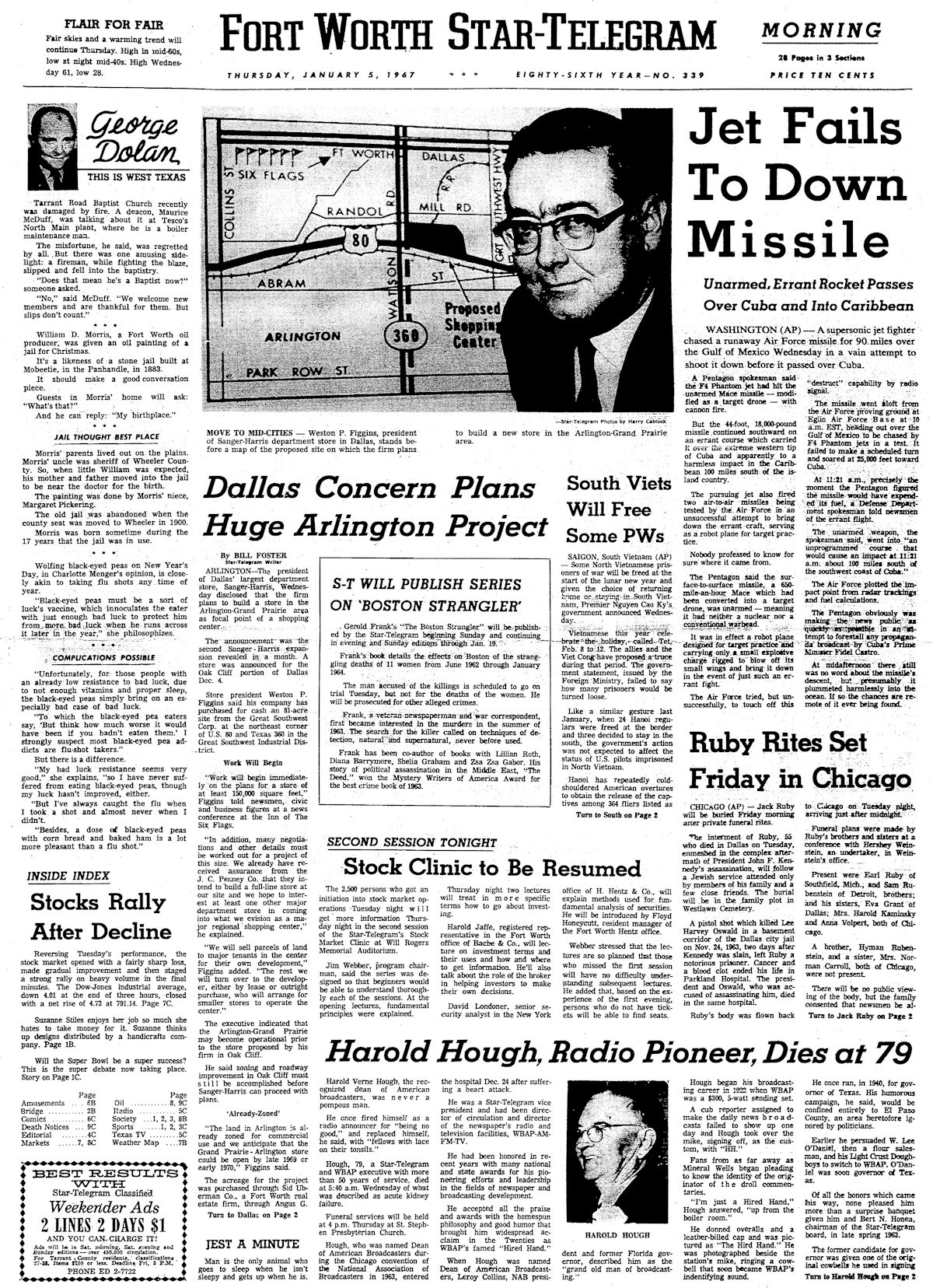 Fast-forward through twenty more years of evolution at WBAP-TV and NBC—color broadcasts, videotape, the Early Bird satellite. Harold Hough died in 1967.
Fast-forward through twenty more years of evolution at WBAP-TV and NBC—color broadcasts, videotape, the Early Bird satellite. Harold Hough died in 1967.
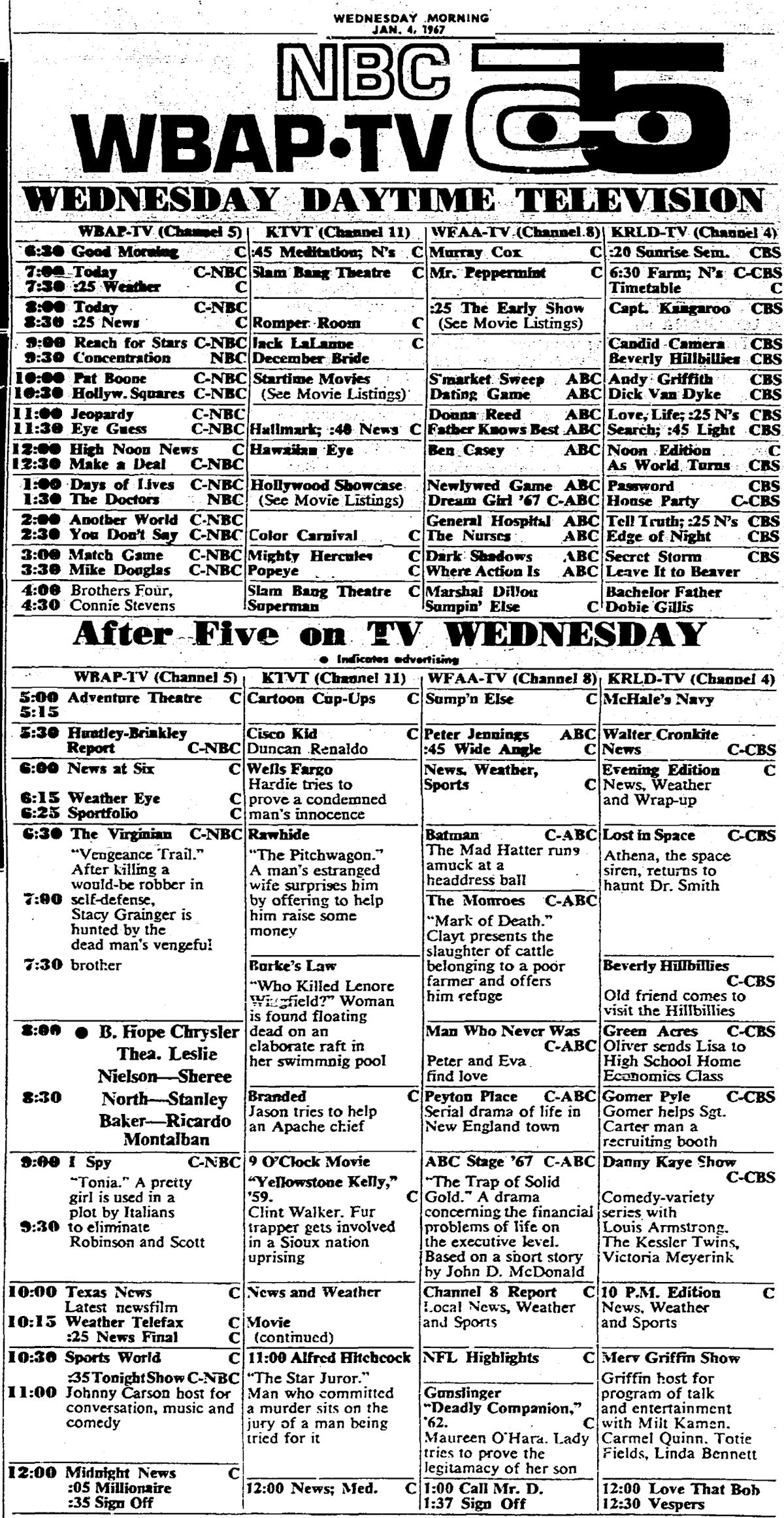 This was WBAP-TV’s programming schedule on the day Hough died—twelve hours, mostly in color.
This was WBAP-TV’s programming schedule on the day Hough died—twelve hours, mostly in color.
Upon Hough’s death the Star-Telegram wrote of him in an editorial: “He was an authentic pioneer in the field of radio and television, with an almost uncanny ability to foresee technological developments in these mediums and divine their importance when they were still beyond the scientific horizon. The practicality of television itself he saw almost before radio ceased to be a novelty, and color TV he forecast and talked about and promoted long before the many-hued NBC peacock made its appearance.”
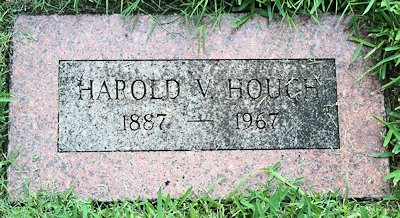 Harold Hough, the mass communications pioneer who put the “Program”—and even the “Pachyderm”—in “WBAP,” is buried in Greenwood Cemetery.
Harold Hough, the mass communications pioneer who put the “Program”—and even the “Pachyderm”—in “WBAP,” is buried in Greenwood Cemetery.
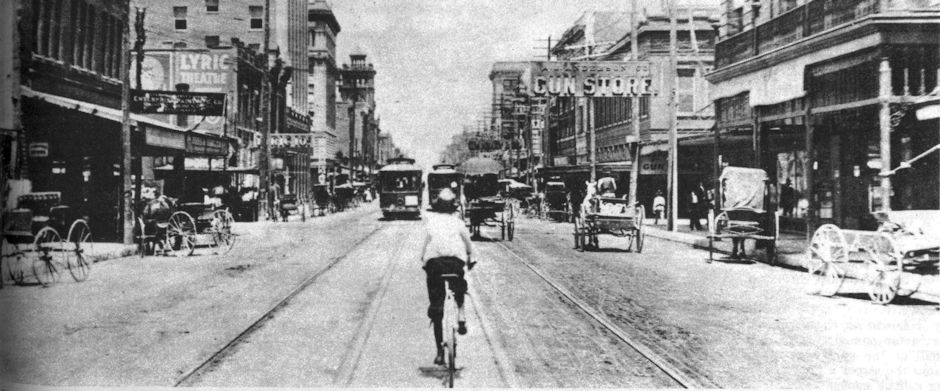





Slam Bang Theatre on same time as Mr. Peppermint! I remember because as an itty bitty thing I started out watching Mr. Peppermint but then one morning I got up and found my teenage uncle watching Slam Bang Theatre and saw grown men throwing pies at each other and I was hooked!?. No more Mr. Peppermint!
Those two made an indelible impression on thousands of us kids.
Does anyone know the name of the theme song for The Texas News?
Jan, I have read that the song was originally entitled “Broad Street March” and retitled “Texas News March” for use as the theme song.